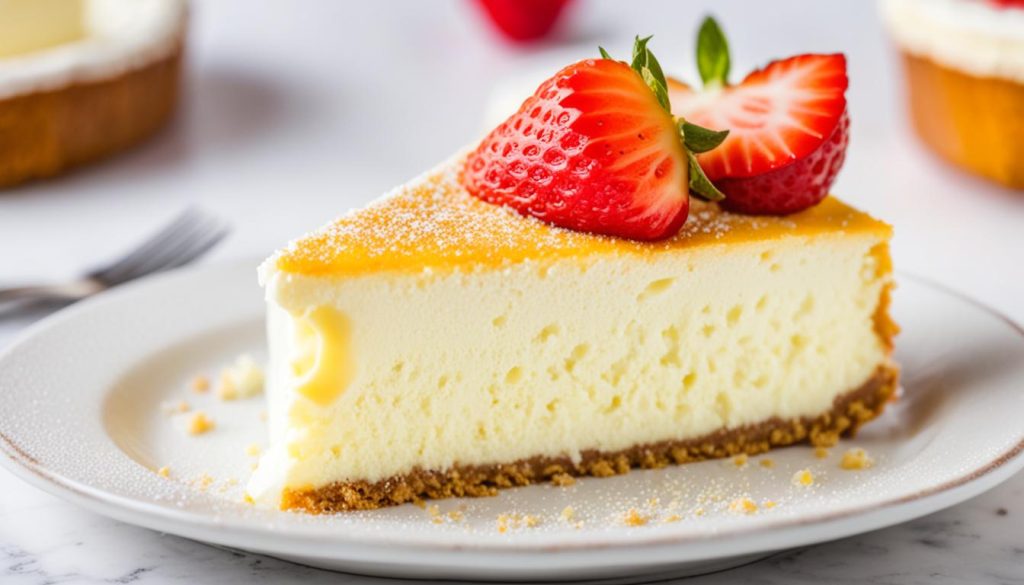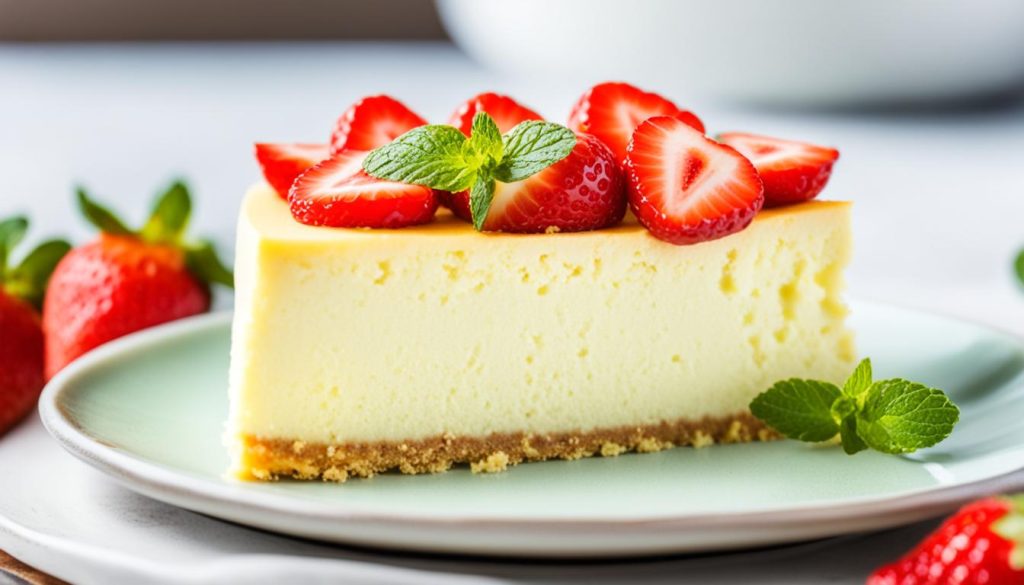Table of Contents
Do you dream of creating a fluffy, jiggly, and light Japanese cheesecake that will impress your friends and family? What if we told you there’s a secret to achieving the perfect texture and taste? Well, get ready to unlock the mystery because we’re about to share the techniques and secrets to making the ultimate Japanese souffle cheesecake. Prepare to indulge in a heavenly dessert that will leave everyone craving for more!
Japanese cheesecake has taken the dessert world by storm with its unique combination of a traditional cheesecake and a chiffon cake. The result is a cheesecake that’s incredibly airy, soft, and oh-so-jiggly. But how do you achieve that magical texture? We’ll guide you through the ingredients, techniques, and baking process to ensure your Japanese cheesecake turns out perfect every time.
So get your apron on, preheat the oven, and get ready to embark on a delicious journey to create the most incredible light and airy Japanese cheesecake you’ve ever tasted. Let’s dive in!
What is Japanese Cheesecake?
Japanese cheesecake, also known as Japanese souffle cheesecake or Japanese cotton cheesecake, is a unique type of cheesecake that originated in Japan. It is a blend of a traditional cheesecake and a chiffon cake, resulting in a light and fluffy texture. The key to its characteristic jiggly nature lies in the baking and mixing techniques used.
If you’re unfamiliar with Japanese cheesecake, imagine a cross between a classic cheesecake and a delicate souffle. It has a velvety smooth texture, a subtle tanginess from the cream cheese, and a cloud-like lightness that makes it simply irresistible. The secret to achieving this ethereal texture lies in a few key steps and ingredients.
The Baking and Mixing Techniques
Japanese cheesecake is made by incorporating a meringue – whipped egg whites – into the cheesecake batter. The meringue adds volume and creates those whimsical air pockets that give the cheesecake its signature jiggle. When folding the meringue into the batter, it’s important to do it gently and slowly, so as not to deflate the airy texture.
The cake is then baked in a water bath, which provides a humid environment and prevents the cheesecake from drying out. This gentle and slow baking method helps the cake rise evenly and ensures a tender crumb. The result? A light, fluffy, and melt-in-your-mouth cheesecake that’s unlike anything you’ve ever tasted.
Japanese cheesecake is often enjoyed on its own, without any additional toppings. Its delicate flavor and melt-in-your-mouth texture are enough to satisfy any dessert lover. However, you can get creative and top it with powdered sugar, fresh fruit, or even a drizzle of chocolate sauce if you’d like to add a touch of sweetness.
Now that you know what Japanese cheesecake is, it’s time to dive into the ingredients and techniques that make it so special. Let’s explore how to create the perfect Japanese cheesecake in the next section!
The Ingredients and Techniques
Creating a delicious Japanese cheesecake requires a combination of carefully selected ingredients and precise techniques. Let’s take a look at what goes into making this light and airy dessert.
Ingredients:
- Cream cheese
- Eggs
- Sugar
- Flour
- Butter
- Milk
To begin, melt the cream cheese, butter, and milk together until they form a smooth and creamy batter. This step ensures a silky texture in the final cheesecake. Make sure to use high-quality cream cheese for the best results.
Next, separate the egg whites from the yolks. Whip the egg whites until they reach stiff peaks. This process adds air to the batter, resulting in a light and fluffy cheesecake. Be patient and continue whisking until the desired consistency is achieved.
Now, it’s time to fold the whipped egg whites into our batter. This technique maintains the delicate texture of the egg whites while incorporating them evenly into the mixture. Gently combine the egg whites with the cream cheese mixture using a spatula, taking care not to overmix.
Techniques:
One crucial technique for Japanese cheesecake is baking it in a water bath. This involves placing the cake pan inside a larger pan filled with some water, then baking it in the oven. The steam created from the water bath provides moisture and helps prevent the cheesecake from cracking while baking. It also promotes an even rise and a tender texture.
Preheat the oven to the specified temperature stated in your recipe. Prepare the cheesecake batter and pour it into the cake pan. Place the cake pan into the larger pan filled with 1-2 inches of hot water, ensuring that the water does not enter the cake pan. The water bath should reach about halfway up the sides of the cake pan.
Once ready, carefully transfer the pans to the oven and bake according to the specified time and temperature. Remember to follow the baking instructions precisely to achieve the perfect Japanese cheesecake texture.
While the cheesecake bakes, resist the temptation to open the oven door too frequently as this may cause the cake to deflate or crack. Instead, rely on the oven light to monitor its progress.
After baking, remove the cheesecake from the water bath and allow it to cool before unmolding. The result is a fluffy and jiggly Japanese cheesecake that is sure to impress your family and friends.

The Perfect Baking Process
When it comes to making the best Japanese Cheesecake, the baking process plays a crucial role. By following the perfect technique, you can ensure your cheesecake turns out light, fluffy, and authentic.
Start by preheating your oven to the recommended temperature mentioned in the recipe. This step is important to ensure that the cake bakes evenly and rises properly.
Next, prepare your baking pan by lining it with parchment paper. This prevents the cake from sticking to the pan and makes it easier to remove once it’s done. Alternatively, you can also grease the pan with butter or cooking spray.
Creating a water bath is essential for achieving the ideal texture and preventing the cake from drying out. To create a water bath, place your prepared baking pan inside a larger baking dish or roasting pan. Fill the larger pan with hot water, making sure it reaches about halfway up the sides of the smaller pan.
Now it’s time to pour your Japanese cheesecake batter into the prepared pan. Smooth out the top with a spatula to ensure an even surface.
To further enhance the jiggly and airy texture, the cake should be baked at a high temperature initially. This initial high heat helps to create a rise in the cake. Afterward, lower the temperature to ensure that the cheesecake is fully cooked on the inside without burning the top.
Throughout the baking process, keep an eye on the cake and avoid opening the oven door too often, as this can cause the cake to deflate. Once the cheesecake turns a light golden brown and feels set, it is time to remove it from the oven. The center should still have a slight jiggle, which is a sign of a perfectly baked Japanese cheesecake.
Allow the cheesecake to cool in the pan for a while before transferring it to a wire rack to cool completely. This helps to prevent any potential collapsing due to sudden temperature changes.
Remember, the perfect baking process is key to achieving an authentic Japanese cheesecake with its signature fluffy texture and delicate flavor. Now that you know the secrets to baking the best Japanese cheesecake, it’s time to try it for yourself and indulge in a slice of pure deliciousness!
Tips and Troubleshooting
When making Japanese cheesecake, it’s important to follow the recipe and techniques closely to achieve the desired fluffy and jiggly texture. Here are some tips to help you succeed:
- Use room temperature ingredients: Make sure your cream cheese, eggs, and other ingredients are at room temperature before you begin. This will ensure that they blend smoothly and create a silky batter.
- Whip the egg whites properly: Be sure to whip the egg whites until stiff peaks form. This will incorporate air into the batter and give your cheesecake its light and airy texture.
- Avoid over-mixing the batter: Once you’ve combined the melted cream cheese mixture with the whipped egg whites, gently fold them together until just combined. Over-mixing can deflate the batter and result in a dense cheesecake.
If you encounter any issues while making Japanese cheesecake, here are some troubleshooting steps:
- Cracking: If your cheesecake cracks during baking, it may be due to a sudden change in temperature. Make sure to cool the cake gradually by turning off the oven and leaving the door slightly ajar before removing the cake.
- Deflating: If your cheesecake deflates after baking, it may be because the egg whites were not beaten to stiff peaks or were over-folded into the batter. Next time, be sure to whip the egg whites properly and gently fold them into the batter.
By following these tips and troubleshooting steps, you can ensure that your Japanese cheesecake turns out fluffy, jiggly, and absolutely delicious!
Serving and Enjoying Japanese Cheesecake
Now that you’ve successfully baked a light and airy Japanese cheesecake, it’s time to savor the delightful flavors and enjoy it to the fullest. Japanese cheesecake is best served when it is still warm or at room temperature, allowing you to experience the full texture and taste.
Here are some tips for serving and enjoying your Japanese cheesecake:
- 1. Serve it as is: You can enjoy the deliciousness of Japanese cheesecake on its own, appreciating the delicate balance of flavors and the soft texture.
- 2. Add powdered sugar: A dusting of powdered sugar on top of the cheesecake adds a touch of sweetness and enhances the visual appeal.
- 3. Pair it with fruits: Fresh fruits like strawberries, blueberries, or raspberries make for a delightful topping. The slightly tangy and juicy fruits beautifully complement the creamy cheesecake.
- 4. Drizzle it with sauce: A drizzle of chocolate or caramel sauce adds a luxurious touch to your Japanese cheesecake. The combination of the silky sauce and the fluffy cheesecake creates a heavenly dessert.
Remember that while Japanese cheesecake is incredibly delicious, its jiggly and fluffy texture won’t be maintained when refrigerated. However, even when chilled, it still retains its light and airy taste, making it a delightful treat whenever you decide to indulge.
The History of Japanese Cheesecake
Japanese cheesecake has a fascinating history that dates back to the 1960s. It all started when a talented Japanese chef got inspired by the German käsekuchen, a traditional cheesecake. But he wanted to create something lighter and less sweet, a unique twist on the classic dessert.
With his culinary skills and creativity, the chef developed a recipe that would later become known as Japanese cheesecake. This delightful treat quickly gained popularity in Japan, captivating dessert lovers with its delicate texture and delightful flavor.
Word of the Japanese cheesecake’s appeal spread, and it soon found its way to other countries as well. People from all walks of life discovered the joy of indulging in a slice of this delectable dessert.

Today, Japanese cheesecake continues to be adored and enjoyed by many. Its fluffy texture, lightness, and unique taste make it a perfect treat for any occasion. Whether you’re a cheesecake connoisseur or new to the world of Japanese desserts, this delicacy is sure to leave you craving for more.
Variations and Flavorings
While the classic Japanese cheesecake is a delicious treat on its own, you can enhance its taste with variations and flavorings. By incorporating ingredients like matcha powder, cocoa powder, or extracts such as vanilla or lemon, you can create unique flavors that add a delightful twist to the traditional Japanese cheesecake.
One popular variation is matcha-flavored Japanese cheesecake. Matcha powder, made from finely ground green tea leaves, gives the cheesecake a vibrant green color and a distinct, earthy flavor. Its slightly bitter undertones complement the creamy sweetness of the cheesecake, creating a harmonious balance of flavors.
For chocolate lovers, adding cocoa powder to the cheesecake batter can create a rich and indulgent dessert. The deep, chocolatey flavor pairs well with the creamy texture of the cheesecake, resulting in a decadent treat that satisfies any chocolate craving.
If you prefer a more traditional taste, using extracts like vanilla or lemon can elevate the flavor profile of the cheesecake. Vanilla adds a warm and sweet aroma, while lemon imparts a refreshing citrusy tang. These simple additions bring a subtle yet delightful twist to the classic Japanese cheesecake.
Whether you choose to experiment with matcha, cocoa, vanilla, lemon, or other flavorings, the variations and flavor combinations are endless. Get creative in your kitchen and let your taste buds guide you in creating a Japanese cheesecake that suits your unique preferences.
Conclusion
Japanese cheesecake is a delightful dessert that captures the hearts of dessert lovers with its fluffy and jiggly texture. By following the proper techniques and using the right ingredients, you can create an authentic Japanese cheesecake that is sure to impress.
Experimenting with variations and flavorings allows you to add your own personal touch to this delicious treat. Whether you choose to incorporate matcha powder, cocoa powder, or extracts like vanilla or lemon, these additions can elevate the flavor profile of your Japanese cheesecake.
Take pleasure in the process of making and savoring the light and airy goodness of Japanese cheesecake. Its unique combination of a traditional cheesecake and a chiffon cake results in a dessert that is not only visually appealing but also incredibly delectable.

